-
 Bitcoin
Bitcoin $103,391.2948
0.63% -
 Ethereum
Ethereum $2,462.3102
6.49% -
 Tether USDt
Tether USDt $1.0001
0.01% -
 XRP
XRP $2.4184
3.24% -
 BNB
BNB $656.0920
3.41% -
 Solana
Solana $171.8681
1.01% -
 USDC
USDC $0.9998
-0.03% -
 Dogecoin
Dogecoin $0.2296
12.77% -
 Cardano
Cardano $0.8106
3.81% -
 TRON
TRON $0.2603
-0.56% -
 Sui
Sui $4.0183
3.00% -
 Chainlink
Chainlink $16.7152
4.94% -
 Avalanche
Avalanche $24.4968
6.35% -
 Stellar
Stellar $0.3052
3.41% -
 Shiba Inu
Shiba Inu $0.0...01593
6.86% -
 Hedera
Hedera $0.2112
6.17% -
 Hyperliquid
Hyperliquid $25.2286
2.27% -
 Toncoin
Toncoin $3.3806
4.04% -
 Bitcoin Cash
Bitcoin Cash $421.6884
3.65% -
 Polkadot
Polkadot $5.0586
6.69% -
 UNUS SED LEO
UNUS SED LEO $8.6242
-0.71% -
 Litecoin
Litecoin $103.3050
4.68% -
 Monero
Monero $325.7429
7.03% -
 Bitget Token
Bitget Token $4.8359
8.60% -
 Pepe
Pepe $0.0...01310
6.86% -
 Dai
Dai $1.0000
-0.01% -
 Pi
Pi $0.7372
2.25% -
 Ethena USDe
Ethena USDe $1.0003
0.00% -
 Uniswap
Uniswap $6.8723
8.99% -
 Bittensor
Bittensor $447.2699
5.58%
What are Bitcoin miners? How do they get rewarded?
Bitcoin miners use specialized ASIC hardware to solve complex puzzles, validating transactions and adding them to the blockchain, earning block rewards and transaction fees.
May 10, 2025 at 01:08 pm
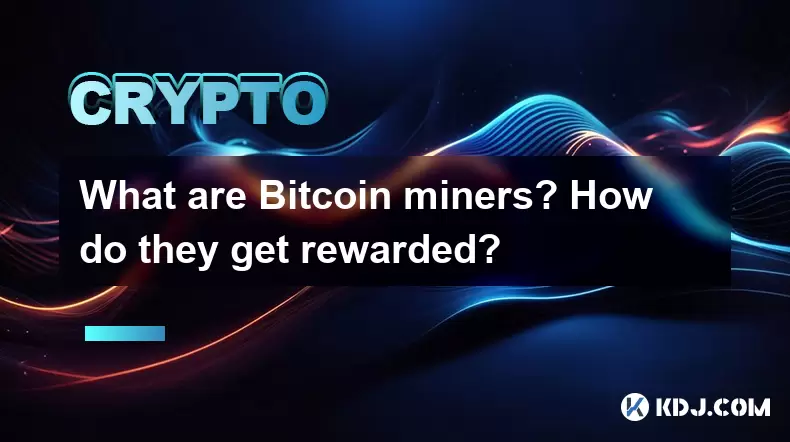
Bitcoin miners are individuals or entities that use specialized computer hardware to solve complex mathematical problems, thereby validating transactions and adding them to the Bitcoin blockchain. Miners play a crucial role in maintaining the security and integrity of the Bitcoin network. Their work ensures that transactions are processed correctly and that the blockchain remains tamper-proof.
The process of mining involves solving cryptographic puzzles, which requires significant computational power. When a miner successfully solves a puzzle, they are granted the right to add a new block of transactions to the blockchain. This process is known as proof-of-work (PoW). The difficulty of these puzzles adjusts automatically to ensure that a new block is added approximately every 10 minutes, regardless of the total computational power of the network.
Miners receive rewards for their efforts in two main ways: block rewards and transaction fees. The block reward is a fixed amount of newly minted bitcoins that the miner receives for successfully adding a new block to the blockchain. Initially set at 50 bitcoins per block, this reward halves approximately every four years in an event known as the Bitcoin halving. As of the latest halving in 2020, the block reward stands at 6.25 bitcoins.
In addition to the block reward, miners also earn transaction fees. These fees are paid by users who want their transactions to be processed quickly. When users submit a transaction to the Bitcoin network, they can attach a fee, which incentivizes miners to include their transaction in the next block. The total fee for a block is the sum of all fees from the transactions included in that block, and this amount is also awarded to the miner who successfully mines the block.
The combination of block rewards and transaction fees forms the total reward for miners. Over time, as the block reward continues to halve, transaction fees are expected to become a more significant portion of miners' total earnings. This shift is essential for the long-term sustainability of the Bitcoin network, as it provides an ongoing incentive for miners to continue validating transactions even after all bitcoins have been mined.
The Role of Mining Hardware
Mining Bitcoin requires specialized hardware known as Application-Specific Integrated Circuits (ASICs). These devices are designed specifically for the purpose of mining cryptocurrencies and are far more efficient than general-purpose computers. The evolution of mining hardware has been driven by the increasing difficulty of the cryptographic puzzles that miners must solve.
Early Bitcoin miners used central processing units (CPUs) and later graphics processing units (GPUs) to mine. However, as the network grew and the difficulty increased, these methods became impractical. ASICs were introduced to address this challenge, offering significantly higher hash rates and energy efficiency. Today, most Bitcoin mining is done using ASICs, which can cost thousands of dollars but are necessary to compete in the highly competitive mining landscape.
The Mining Pool Concept
Given the high difficulty and computational power required to mine Bitcoin, many individual miners join forces to form mining pools. A mining pool is a group of miners who combine their computational resources to increase their chances of solving the cryptographic puzzles and earning rewards. The rewards are then distributed among the pool members based on their contributed computational power.
Joining a mining pool can make mining more predictable and less risky for individual miners. Instead of waiting for the rare event of successfully mining a block on their own, miners in a pool receive smaller, more frequent payouts. This approach can be particularly appealing for those who do not have access to large amounts of capital to invest in mining hardware.
The Environmental Impact of Bitcoin Mining
Bitcoin mining has been a subject of debate due to its significant energy consumption. The process of solving cryptographic puzzles requires substantial electricity, leading to concerns about the environmental impact of mining. Estimates suggest that the Bitcoin network consumes as much electricity as some small countries, prompting discussions about the sustainability of the current mining model.
Efforts are being made to address these concerns. Some miners are turning to renewable energy sources, such as hydroelectric or solar power, to reduce their environmental footprint. Additionally, innovations in mining hardware and algorithms aim to improve energy efficiency, potentially mitigating some of the environmental impact associated with Bitcoin mining.
Setting Up a Bitcoin Mining Operation
For those interested in becoming Bitcoin miners, setting up a mining operation involves several steps. Here's a detailed guide on how to get started:
Research and Choose Mining Hardware: Start by researching available ASIC miners and selecting one that fits your budget and mining goals. Consider factors such as hash rate, power consumption, and price.
Acquire the Hardware: Purchase the chosen ASIC miner from a reputable supplier. Be prepared for potential lead times, as high demand can result in delays.
Set Up the Mining Environment: Ensure you have a suitable space for your mining operation. This should be well-ventilated and equipped with the necessary power infrastructure to support your hardware.
Install Mining Software: Download and install mining software that is compatible with your ASIC miner. Popular options include CGMiner, EasyMiner, and MultiMiner.
Configure the Software: Set up your mining software to connect to a mining pool or to mine solo. Enter the pool's details, such as the pool URL, username, and password, if joining a pool.
Connect to the Bitcoin Network: Ensure your mining setup is connected to the internet and can communicate with the Bitcoin network. This is crucial for receiving and validating transactions.
Monitor and Maintain: Regularly monitor your mining operation to ensure it is running efficiently. Keep an eye on temperatures, hash rates, and any error messages. Perform routine maintenance to extend the life of your hardware.
The Economics of Bitcoin Mining
The profitability of Bitcoin mining depends on several factors, including the cost of electricity, the efficiency of the mining hardware, and the current price of Bitcoin. Miners must carefully calculate these variables to determine whether their mining operation will be profitable.
Electricity costs are often the most significant expense for miners. In regions where electricity is cheap, mining can be more profitable. Conversely, in areas with high electricity costs, miners may struggle to break even. Some miners choose to relocate their operations to regions with lower electricity costs to improve their margins.
The efficiency of the mining hardware also plays a critical role. More efficient ASICs consume less power per hash, reducing operating costs and increasing profitability. However, these devices are typically more expensive upfront, so miners must weigh the initial investment against potential long-term savings.
Finally, the price of Bitcoin directly impacts mining profitability. When the price of Bitcoin is high, miners can earn more from their rewards. Conversely, if the price drops significantly, miners may find themselves operating at a loss. This volatility is a risk that all miners must consider when entering the mining business.
Frequently Asked Questions
Q: Can I mine Bitcoin using a regular computer?
A: While it is technically possible to mine Bitcoin using a regular computer, it is no longer practical due to the high difficulty of the cryptographic puzzles. Modern Bitcoin mining requires specialized ASIC hardware to be competitive.
Q: How long does it take to mine one Bitcoin?
A: The time it takes to mine one Bitcoin depends on several factors, including the miner's hash rate, the total hash rate of the Bitcoin network, and the current block reward. On average, with a typical ASIC miner, it could take months or even years to mine one Bitcoin.
Q: Is Bitcoin mining legal?
A: The legality of Bitcoin mining varies by country. In many places, it is legal, but some countries have restrictions or bans on cryptocurrency mining. It's essential to check local regulations before starting a mining operation.
Q: Can I mine Bitcoin without joining a mining pool?
A: Yes, it is possible to mine Bitcoin solo without joining a mining pool. However, solo mining is much less predictable and can take a long time to earn a reward due to the high difficulty of solving the cryptographic puzzles.
Disclaimer:info@kdj.com
The information provided is not trading advice. kdj.com does not assume any responsibility for any investments made based on the information provided in this article. Cryptocurrencies are highly volatile and it is highly recommended that you invest with caution after thorough research!
If you believe that the content used on this website infringes your copyright, please contact us immediately (info@kdj.com) and we will delete it promptly.
- XRP Whales Accumulate 880M Tokens As Bulls Aim to Break Through Resistance
- 2025-05-11 01:10:12
- EchoStar Corporation (NASDAQ: SATS) closed at $24.19 on May 9, gaining 1.43% after reporting mixed first-quarter 2025 results.
- 2025-05-11 01:10:12
- Bitcoin (BTC) Still Struggles to Reach the Symbolic Target of $150,000, Despite a Recent Rebound to $104,000
- 2025-05-11 01:05:12
- Here’s How Many Bitcoin (BTC) Holders Are Profiting at the Moment
- 2025-05-11 01:05:12
- Belo Horizonte city council votes to declare the city the “Capital of Bitcoin.”
- 2025-05-11 01:00:12
- Crypto Market Cap Reaches $103K as Bitcoin ($BTC) Price Surges 0.30%
- 2025-05-11 01:00:12
Related knowledge
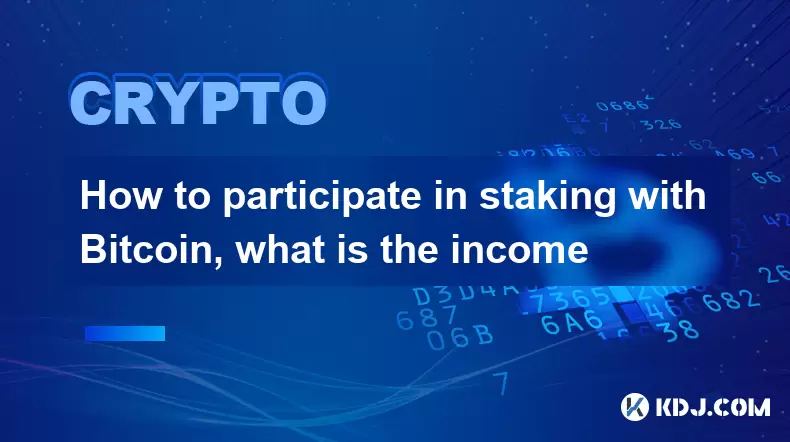
How to participate in staking with Bitcoin, what is the income
May 10,2025 at 02:50pm
Introduction to Bitcoin StakingBitcoin, the pioneer cryptocurrency, traditionally operates on a Proof of Work (PoW) consensus mechanism. However, with the advent of technologies like Bitcoin Staking, users can now participate in a different way to earn income from their Bitcoin holdings. Bitcoin Staking involves locking up your Bitcoin to support the op...

How to determine the buying and selling points with Bitcoin, what are the indicators
May 10,2025 at 03:42am
Introduction to Bitcoin TradingBitcoin, the pioneering cryptocurrency, has attracted numerous traders looking to profit from its volatile price movements. Determining the right buying and selling points is crucial for success in trading Bitcoin. Traders often rely on various technical indicators to make informed decisions. In this article, we will explo...
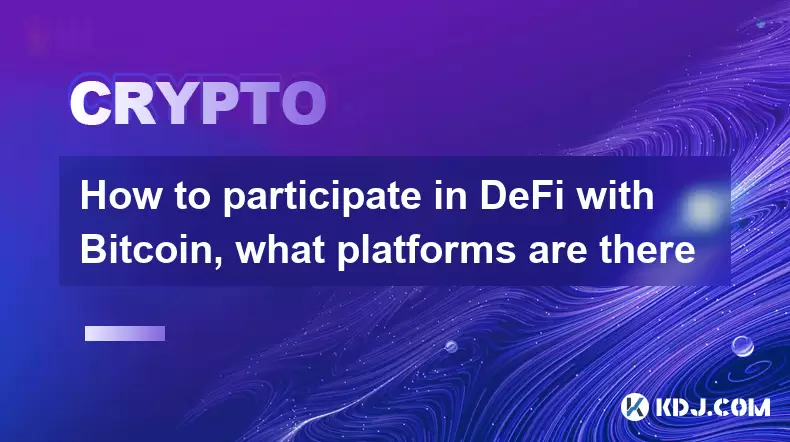
How to participate in DeFi with Bitcoin, what platforms are there
May 10,2025 at 07:49am
Participating in decentralized finance (DeFi) with Bitcoin has become increasingly popular as more platforms enable users to leverage their Bitcoin holdings in various DeFi applications. This article will explore how you can participate in DeFi with Bitcoin and introduce some of the key platforms that facilitate this. Understanding DeFi and Bitcoin Inte...
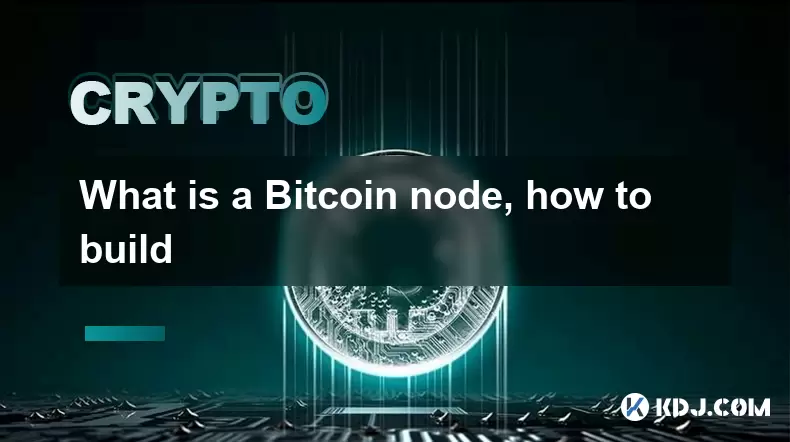
What is a Bitcoin node, how to build
May 11,2025 at 01:00am
A Bitcoin node is a crucial component of the Bitcoin network, serving as a point of communication and validation within the decentralized system. Essentially, a Bitcoin node is a computer that runs the Bitcoin software and fully validates transactions and blocks. By operating a node, you contribute to the security and decentralization of the network, as...
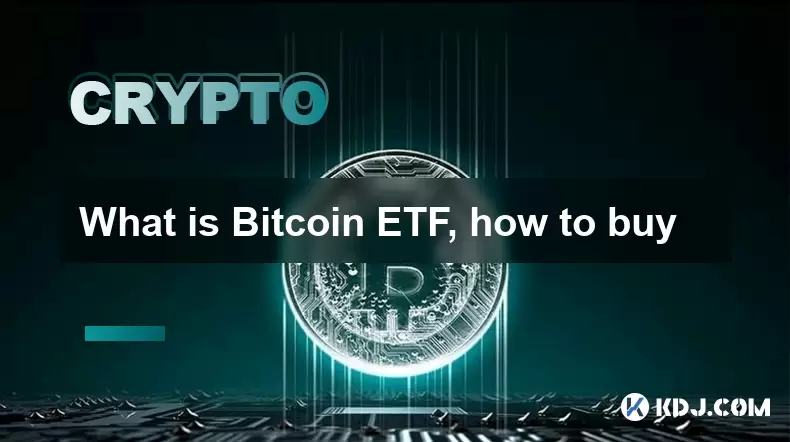
What is Bitcoin ETF, how to buy
May 10,2025 at 10:21am
A Bitcoin ETF, or Exchange Traded Fund, is a type of investment vehicle that allows investors to gain exposure to Bitcoin without directly owning the cryptocurrency. Bitcoin ETFs are traded on traditional stock exchanges, making them more accessible to investors who are familiar with stock market trading but hesitant to engage with cryptocurrency exchan...
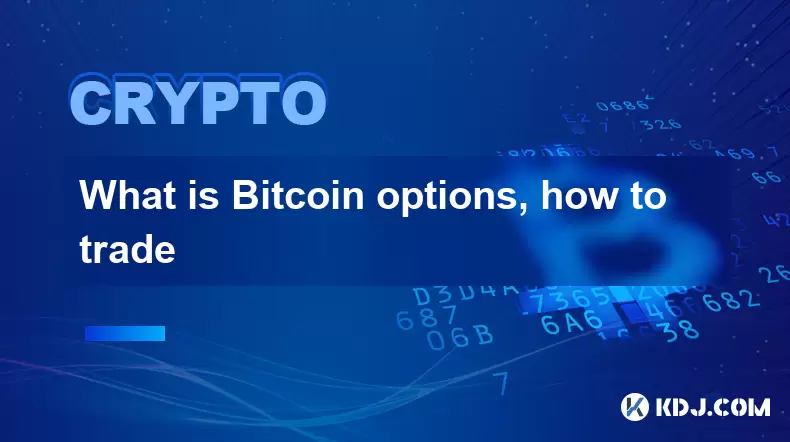
What is Bitcoin options, how to trade
May 10,2025 at 03:49am
Bitcoin options are financial derivatives that give the holder the right, but not the obligation, to buy or sell Bitcoin at a specified price on or before a certain date. These instruments are popular among traders who want to hedge their Bitcoin investments, speculate on Bitcoin's price movements, or generate income from their holdings. Trading Bitcoin...

How to participate in staking with Bitcoin, what is the income
May 10,2025 at 02:50pm
Introduction to Bitcoin StakingBitcoin, the pioneer cryptocurrency, traditionally operates on a Proof of Work (PoW) consensus mechanism. However, with the advent of technologies like Bitcoin Staking, users can now participate in a different way to earn income from their Bitcoin holdings. Bitcoin Staking involves locking up your Bitcoin to support the op...

How to determine the buying and selling points with Bitcoin, what are the indicators
May 10,2025 at 03:42am
Introduction to Bitcoin TradingBitcoin, the pioneering cryptocurrency, has attracted numerous traders looking to profit from its volatile price movements. Determining the right buying and selling points is crucial for success in trading Bitcoin. Traders often rely on various technical indicators to make informed decisions. In this article, we will explo...

How to participate in DeFi with Bitcoin, what platforms are there
May 10,2025 at 07:49am
Participating in decentralized finance (DeFi) with Bitcoin has become increasingly popular as more platforms enable users to leverage their Bitcoin holdings in various DeFi applications. This article will explore how you can participate in DeFi with Bitcoin and introduce some of the key platforms that facilitate this. Understanding DeFi and Bitcoin Inte...

What is a Bitcoin node, how to build
May 11,2025 at 01:00am
A Bitcoin node is a crucial component of the Bitcoin network, serving as a point of communication and validation within the decentralized system. Essentially, a Bitcoin node is a computer that runs the Bitcoin software and fully validates transactions and blocks. By operating a node, you contribute to the security and decentralization of the network, as...

What is Bitcoin ETF, how to buy
May 10,2025 at 10:21am
A Bitcoin ETF, or Exchange Traded Fund, is a type of investment vehicle that allows investors to gain exposure to Bitcoin without directly owning the cryptocurrency. Bitcoin ETFs are traded on traditional stock exchanges, making them more accessible to investors who are familiar with stock market trading but hesitant to engage with cryptocurrency exchan...

What is Bitcoin options, how to trade
May 10,2025 at 03:49am
Bitcoin options are financial derivatives that give the holder the right, but not the obligation, to buy or sell Bitcoin at a specified price on or before a certain date. These instruments are popular among traders who want to hedge their Bitcoin investments, speculate on Bitcoin's price movements, or generate income from their holdings. Trading Bitcoin...
See all articles






















































































